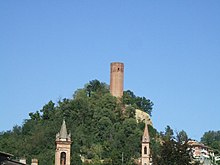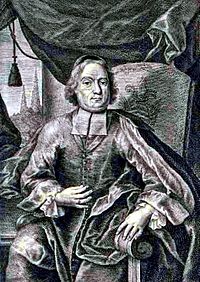Braida from Ronsecco and Cornigliano
Braida von Ronsecco and Cornigliano (historically also written (de) Brayda ; Italian : conti di Ronsecco; signori di Corneliano, etc.) is an ancient noble family from Savoy and belongs to the Italian , Hungarian and Austrian counts .
history

The Counts Braida of Ronsecco and Cornigliano are an old family, originally from Savoy, who can be traced back to the Aleramides . Aleramo I, Conte di Savona (Aledram di Vado) † 995, was Duke in Saxony and cousin and father-in-law of Emperor Otto I , who gave him the Duchy of Montferrat . Aleramos great-grandson Raimund (Raimondo), from the dynasty of the Margraves of Savona and Saluzzo , belonged to parts of Saluzzo, the city and the area of Bra (Piedmont) , from which he and his descendants had taken the name "Braida". The dispute over sovereignty and the wars under Emperor Friedrich Barbarossa forced Otto Heinrich (Oddo Enrico) Marchese di Braida i Cornigliano, Centallo and Racconigi to cede to Adelasia von Salluzzo (before 1200).
The family branched out into several lines in what is now Italy. Own coats of arms were carried. For example, one can find descendants of Odo di Braida di Molioterno (* 1269), married to Odolina D'Aimone d'Aquino, in Corneliano . In 1608 the last "Dominus von Corneliano", Count Francesco de Brayda de 'Signori di Corneliano et Podestà di Bagnasco, died there (coat of arms described below).
The full Italian title is: conti di Ronsecco; signori di Brondello, Casalgrasso, Cervere, Corneliano, La Morra, Monforte, Piobesi, Pollenzo, Racconigi, Ronsecco, Ruffia, Sanfrè, Verduno; consignori di Casalvolone, Castellar, Ceresole e Palermo .
Austrian line

Besso di Braida married Lucretia, heiress of the Counts of Ronsecco , whose name he took on. His son Johann († November 12, 1632), Grand Chancellor and Senate President under Karl Emanuel von Savoyen , had 14 children, of whom three sons, Johann, Franz and Julian, entered Austrian service. Julian, the imperial general, married Juliana, the heir to the Baron von Mers, which brought him several estates in Silesia. After he had received the incolate in Bohemia, Moravia and Silesia from Emperor Leopold I in 1669 , he bought the rulership of Ratschitz in the Brno district in 1670 . He was raised to the status of count in hereditary terms with a diploma dated December 10, 1674. Martha Maria widowed Baroness von Blier, née Countess von Braida, bought the Selletitz estate in the Znojmo district in 1663 . Remarried as Baroness von Portenau, she sold the property four years later to the family of the Counts of Berchtold , who in 1711 also acquired the Zerotitz and Wainitz estates from Martha Maria's heirs . Karel Antonín Graf Braida sold Ratschitz in 1800.
The family in Moravia also owned the lordships and estates of Morkowitz, Schlappanitz, Gifikowitz, Traubek, Weiss-Oehlhütten, Czekin, Klein-Pentschitz and Lhota-Zabecny, but in 1899 the family in Moravia was unmarried from the former property. She has owned the Austrian Sitzenthal Castle since 1897 .
Personalities
Giovanni de Brayda, Conte di Bra, Sanfre, Ronsecco e Piobesi , (* around 1240; † 1309 in Bra), son of Oddone di Brayda, general of the cavalry of Charles I of Anjou and received Moliterno in 1269, was with Margherita, Contessa del Carretto, Marchesa di Noli, Finale (* 1255 in Finale, † 1301 in Bra), granddaughter of Emperor Friedrich II. , Married.
Besso di Braida (* 1535 in Turin , † 1610 in Ronsecco) came back into the possession of Ronsecco. Before 1580 he married Lucretia, heir daughter of the Lord of Bondonis, Count of Ronsecco, whose title he added to his name. Only one son is likely to have reached manhood.
Gian (Giovanni) Andrea Braida Conte di Ronsecco (* 1581 in Pavia ; † November 12, 1632 in Turin), Besso's son, was Grand Chancellor, Senate President and presiding judge in Piedmont under Duke Charles Emanuel I of Savoy and had 14 children from two of his sons (Francesco (Franz) Luciano and Giuliano (Julian)) entered the service of the Austrian Habsburgs. His eldest son, Giovanni, became master of ceremonies with Duke Vittorio Amadeo II of Savoy .
Julian Count Braida von Ronsecco and Cornigliano (* 1612 in Turin, † 1682 in Vienna ), imperial general , first received by the highest resolution of Emperor Leopold I the incolate for Bohemia , Moravia and Silesia (November 13, 1669), then he was with a diploma of December 10, 1674 raised to the status of herbland count. Through his marriage to the heirloom of Baron von Mers, numerous goods fell to him. In 1670 he bought Ratschitz with castle for 38,000 florins. He also owned the following estates and estates: Groß-Heintzendorf, Drnowitz, Morkowitz, Schlappanitz, Girikowitz, Traubeck, Weiß-Ölhütten, Czekin, Klein-Pentitz and Lhota Zabecny. From 1658 to 1660 he was a colonel-owner of the Cürassier Regiment Braida
Count Franz Julian Braida of Ronsecco and Cornigliano (* March 7, 1654 in Znojmo ; † November 11, 1727 Olomouc) , eldest son of Julian, canonicus of the high cathedral monastery of St. John in Breslau , Vicarius Officialis of Olomouc, archdeacon of Znojmo Canonicus senior, Canon of Wroclaw, became Bishop of Hippo and Auxiliary Bishop of Olomouc under Cardinal von Schrattenbach on June 4, 1703. During his frequent absence he held the office of Viceroy of Naples . A peculiarity was that Braida all prelates who lived in Moravia during his time invested.
Franz Julian was lord of Ratschitz, Gross-Heintzendorf in the Lüben district, as well as Herbersdorf, Neugut, Neudorf, Parchau in the Polckwitz district of the Principality of Glogau and others. He assigned these possessions to his nephew and ward Anton Paul (1703–1794).
Johann Anton (Giovanni Antonio) Conte Braida di Ronsecco e Cornegliano , son of the master of ceremonies, first entered papal and then Austrian services, where he earned merit as a colonel during the siege of Speyer. Only the son Anton Paul (born January 11, 1703 in Vienna, † January 20, 1794 in Ratschitz), who emerged from his marriage to Martha Maria Contessa Santi de Castello, continued the sex.
coat of arms
Three rafters are fixed as the coat of arms of the family coat of arms, but the colors of the shield and the rafters are indicated differently. Some paint the shield silver, the rafters blue. Others, for example Heinrich Kadich von Pferd and Konrad Blažek , the shield blue and the rafters silver.
A memorial stone of Francesco De Brayda (Conte Francesco Brayda de 'Signori di Corneliano et Podestà di Bagnasco) from 1608 shows the coat of arms of the Brayda (Braida) as follows: three rafters in the shield. A growing Fortuna on the helmet with helmet covers as a crest ornament . The blazon of the associated portrayal of Giuseppe Croce: three blue rafters in silver. On the helmet with blue-silver helmet covers a blue clad Fortuna growing. Panier over the helmet: "Bien faire passe tout". The proportions and ornamentation of this depiction are an early testimony to the "heraldic decay".
With the Austrian approval for the continuation of the count's status, the descendants of Count Ludwig Braida zu Vienna were given the following coat of arms on June 17, 1836: square and topped with a red-silver split bar, this topped with a silver heart shield , in it three blue rafters ( family coat of arms ). Field 1 in red shows a retrospective silver lion, field 2 red without a picture, between these two fields a golden middle field is covered with two black bars, field 3 black without a picture, field 4 split by red and gold six times. The count's crown rests on the shield.
According to Ernst Heinrich Kneschke , the increased coat of arms (in Austria) is described with this blazon and therefore represented in different ways: A main shield squared by a wide cross band, in which a broad stake is inserted between the two fields of the upper part, with a central shield. The main shield has seven fields, of which the stake is the second and the bandage is the fourth and fifth. Three blue rafters standing one above the other in the silver central shield. 1 in red a silver inward-facing lion; 2 in gold two black crossbars; 3 red, 4 blue, 5 and 6 black, all without picture, and 7 streaked with red and gold six times the length. The crown of the count covers the shield.
literature
- Ernst Heinrich Kneschke : German count houses of the present: in heraldic, historical and genealogical relation , 1854, p. 40f, digitized
- Genealogical paperback of the count's houses, Gotha 1855
- German Adelsarchiv, Ed. Hans Friedrich von Ehrenkrook: Genealogisches Handbuch des Adels, Volume 58, Verlag CA Starke, 1974
- Notes sheet of the Historical-Statistical Section of the Imperial Royal. Moravian-Silesian * * Society, edited by Christian Ritter d'Elvert, No. 10 from 1869
- Pierer's Universal Lexicon, Volume 3. Altenburg 1857
- Leopold von Zedlitz-Neukirch: New Prussian Nobility Lexicon . Supplement volume (vol. 5), Leipzig 1839, p. 65 f. ( Digitized version )
Individual evidence
- ↑ Andrea Zorzi, La trasformazione di un quadro politico: ricerche su politica e giustizia a Firenze dal comune allo Stato territoriale , Florence 2008, p. 72 ( digitized version )
- ↑ http://www.blasonariosubalpino.it
- ↑ Baldassarre Molino: Brief historical introduction to the place Corneliano ( Memento of the original from January 26, 2008 in the Internet Archive ) Info: The archive link has been inserted automatically and has not yet been checked. Please check the original and archive link according to the instructions and then remove this notice.
- ^ Genealogical paperback of the count's houses, Gotha 1855, p. 56
- ↑ Archive link ( Memento of the original from June 12, 2013 in the Internet Archive ) Info: The archive link was inserted automatically and has not yet been checked. Please check the original and archive link according to the instructions and then remove this notice.
- ↑ http://www.blasonariosubalpino.it/index1.html
- ^ Gregor Wolny , The Margraviate of Moravia , Volume 3 Znojmo District , Brno 1837, p. 502 f. ( Digitized version )
- ↑ a b Heinrich Kadich and Konrad Blažek : Der Mährische Adel , Verlag Bauer & Raspe, Nuremberg 1899, p. 13 ( digitized ; PDF; 64.1 MB)
- ^ Notes sheet of the Historical-Statistical Section of the Imperial Royal. Moravian-Silesian Society, edited by Christian Ritter d'Elvert, No. 10 from 1869, pp. 76–79
- ↑ Prof. Dr. Ernst Heinrich Kneschke: "German count houses of the present: in heraldic, historical and genealogical relation", 3rd volume AZ, Verlag TO Weigel, Leipzig 1854, p. 40 f.
- ^ Pierer's Universal-Lexikon, Volume 3. Altenburg 1857, p. 172
- ↑ Kadich-Blazek, 1899-011-020
- ↑ Wolny's Church Topography, Volume I, p. 108)
- ^ Hradische Annalen MS.
- ↑ Henelii Silesographia renovata, C. VIII., 1704, p. 364
- ^ Ernst Heinrich Kneschke: "German count houses of the present: in heraldic, historical and genealogical relationship", 3rd volume, AZ, Verlag TO Weigel, Leipzig 1854, p. 491
- ↑ The stone is preserved, as is a graphic after it. The archaeologist Federico Eusebio interpreted the inscription in 1910: "Arma dell'illustre et molto potent signor Conte Francesco Brayda de 'Signori di Corneliano et Podestà di Bagnasco" (German something like: coat of arms of the famous and very powerful Count Francesco Brayda [from the Home] of the lords of Corneliano and Podestà of Bagnasco ). Compare with Stemmi a Corneliano a cura del Comitato di Restauro Chiesa della ss. Trinità D'là last Ri , 1994 ( digitized version ( memento of the original from October 2, 2013 in the Internet Archive ) Info: The archive link has been inserted automatically and has not yet been checked. Please check the original and archive link according to the instructions and then remove this note. ) .
- ↑ Bernhard Peter: Heraldry through the centuries: coat of arms styles
- ↑ Genealogisches Handbuch des Adels , Adelslexikon Volume II Boo-Don, Complete Series Volume 58, Limburg an der Lahn 1974, p. 51



